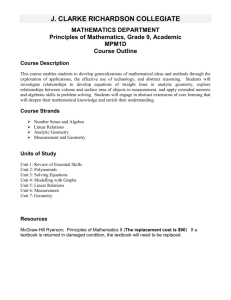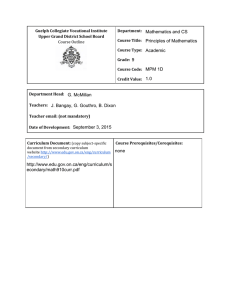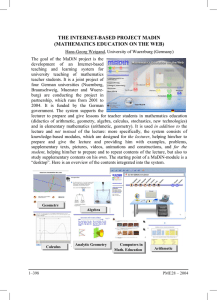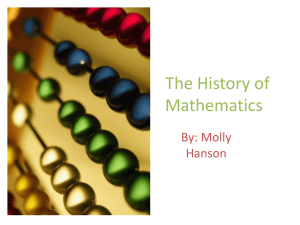DESCRIPTIONS AND CONFLICTS IN DYNAMIC GEOMETRY
advertisement
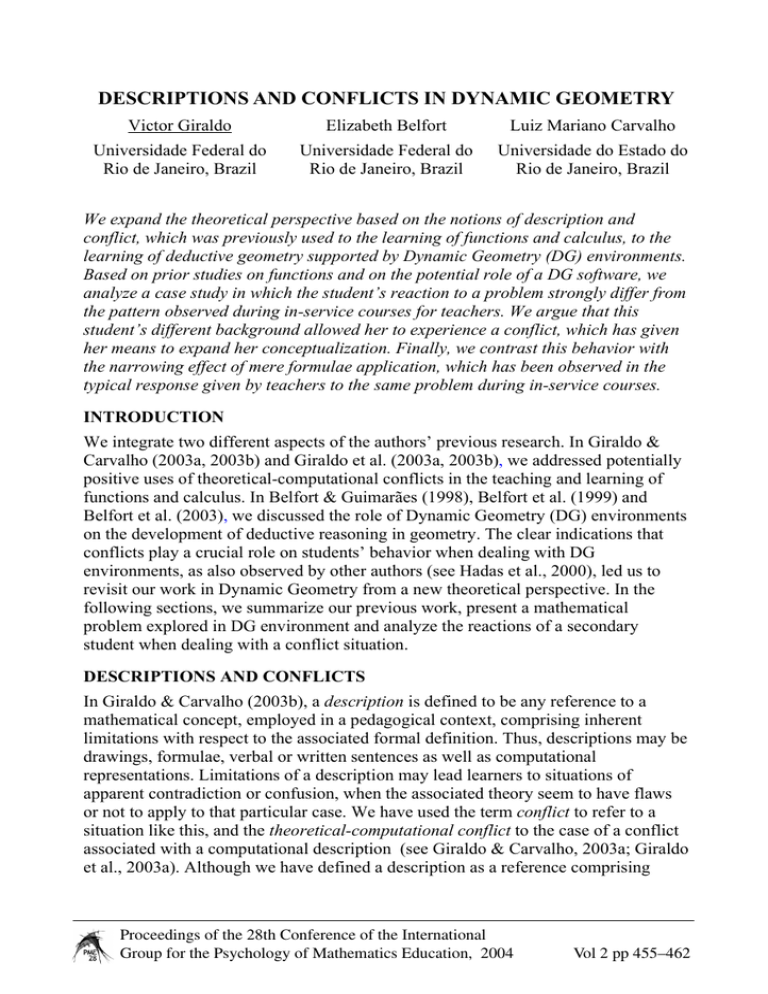
DESCRIPTIONS AND CONFLICTS IN DYNAMIC GEOMETRY Victor Giraldo Elizabeth Belfort Luiz Mariano Carvalho Universidade Federal do Rio de Janeiro, Brazil Universidade Federal do Rio de Janeiro, Brazil Universidade do Estado do Rio de Janeiro, Brazil We expand the theoretical perspective based on the notions of description and conflict, which was previously used to the learning of functions and calculus, to the learning of deductive geometry supported by Dynamic Geometry (DG) environments. Based on prior studies on functions and on the potential role of a DG software, we analyze a case study in which the student’s reaction to a problem strongly differ from the pattern observed during in-service courses for teachers. We argue that this student’s different background allowed her to experience a conflict, which has given her means to expand her conceptualization. Finally, we contrast this behavior with the narrowing effect of mere formulae application, which has been observed in the typical response given by teachers to the same problem during in-service courses. INTRODUCTION We integrate two different aspects of the authors’ previous research. In Giraldo & Carvalho (2003a, 2003b) and Giraldo et al. (2003a, 2003b), we addressed potentially positive uses of theoretical-computational conflicts in the teaching and learning of functions and calculus. In Belfort & Guimarães (1998), Belfort et al. (1999) and Belfort et al. (2003), we discussed the role of Dynamic Geometry (DG) environments on the development of deductive reasoning in geometry. The clear indications that conflicts play a crucial role on students’ behavior when dealing with DG environments, as also observed by other authors (see Hadas et al., 2000), led us to revisit our work in Dynamic Geometry from a new theoretical perspective. In the following sections, we summarize our previous work, present a mathematical problem explored in DG environment and analyze the reactions of a secondary student when dealing with a conflict situation. DESCRIPTIONS AND CONFLICTS In Giraldo & Carvalho (2003b), a description is defined to be any reference to a mathematical concept, employed in a pedagogical context, comprising inherent limitations with respect to the associated formal definition. Thus, descriptions may be drawings, formulae, verbal or written sentences as well as computational representations. Limitations of a description may lead learners to situations of apparent contradiction or confusion, when the associated theory seem to have flaws or not to apply to that particular case. We have used the term conflict to refer to a situation like this, and the theoretical-computational conflict to the case of a conflict associated with a computational description (see Giraldo & Carvalho, 2003a; Giraldo et al., 2003a). Although we have defined a description as a reference comprising Proceedings of the 28th Conference of the International Group for the Psychology of Mathematics Education, 2004 Vol 2 pp 455–462 intrinsic limitations, these limitations may be actualized on the form of conflicts in very diverse manners (if at all). Moreover, the effect of conflicts on learners’ concept images (in the sense of Tall & Vinner, 1981; Tall, 1989, 2000) is not a intrinsic feature of the related description, but depends on the whole pedagogical context, including approach adopted by tutors, learners’ attitudes and beliefs and so on. Mathematics education literature provides examples of positive and negative effects of computers’ limitations. Hunter et al. (1993) observed that students using software Derive did not need to substitute values to get a table and sketch graphs. As a result, they did not develop the skill of evaluating functions by substitution. Even students who could perform the evaluation before the course seemed to have atrophied the skill afterwards. This result uncovers a narrowing effect: the intrinsic characteristics of a description lead to limitations on the concept images developed by learners. In our own interpretation, such effect was not due to conflicts, but on the contrary, to their absence (see Giraldo et al. 2003a). Hadas et al. (2000) present a set of DG activities in which the possibility (or impossibility) of a construction was against students' intuition. The activities were meant to motivate the need to prove, by causing surprise or uncertainty. The proportion of deductive explanations was considerably greater in situations involving uncertainty. The authors conclude that uncertainty brought proofs into the realm of students’ actual arguments. As a result, they naturally engaged into the mathematical activity of proofing. In our previous work, we analyzed effects of computational descriptions for the concept of derivative on undergraduate students’ concept images. In that case, the limitations were strongly related to the fact that the finite structure of computational algorithms is used to describe a mathematical concept theoretically grounded on an infinite limit process. In Giraldo et al. 2003b, we analyzed six students dealing with a computational description for functions in which a differentiable function seemed not to be, due to graphic windows ranges. We observed that for some students, their previous concept images enabled them to almost immediately solve the theoreticalcomputational conflict. For others, the conflict motivated the construction of new cognitive units, acting to enrich their concept images. For others yet, no conflict was actualized. In Giraldo et al. 2003a, we analyzed reactions of a student, Antônio (pseudonym), dealing with tasks involving computational descriptions for differentiable and non-differentiable functions, based on the notion of local straightness. We observed that one particular aspect of Antônio’s beliefs towards the computer played a crucial role on his behavior and strategies: he spells out clear awareness of the device’s limitations and of the possibility of ‘mistaken’ outcomes to be produced. We observed different effects of theoretical-computational conflicts on Antônio’s concept image. In some situations, his previous experience gave him means to quickly grasp the theoretical issues related with the conflicts. In that case, the conflicts acted as a reinforcement factor, strengthening his previous knowledge. In other situations, his knowledge of the subject was not enough to enable him to comprehend what was going on; and the conflicts acted as an expansion factor, triggering new linkages between cognitive units. In other occasions yet, his previous 2–456 PME28 – 2004 beliefs constituted an obstacle to perform the task; and the conflicts acted as a reconstruction factor, prompting him to rethink and rebuild structures in his concept image (see also Giraldo & Carvalho 2003a, 2003b). CONFLICTS IN DYNAMIC GEOMETRY When we consider the use of Dynamic Geometry, similar results are found in Belfort & Guimarães (1998). We observed in-service teachers’ courses dealing with a Dynamic Geometry environment. On one of the activities, teachers were asked to find empirically the rectangle with perimeter 40m and greatest area possible. Due to floating point errors, the software could give approximate values. As a result, some of the teachers obtained the maximum area of 100m 2 , but the values for the side were inconsistent. For example, one of them found sides of 10.03m and 9.97m . We reported that, initially, the teachers ended up in a deadlock, and were unable to figure out the correct answer at all. However, we remark that the further investigation about the software ‘mistake’ led to the necessity to find a theoretical solution for the problem. In fact, similarly to Hadas et al. (2000), we concluded that software’s limitations may be used as a powerful tool for the development of deductive reasoning in geometry (see also Belfort et al., 2003). As discussed in Guimarães et al. (2002), so far, our work on the influence of DG environments was based on previous studies by Parzysz, 1988; Arsac, 1989; Laborde et Capponi, 1994; Balacheff, 1999. In the case of geometry, the concrete object is often a diagram. To understand the differences between the student and the teacher in its exploration, these authors often consider two different objects: a concrete object, the drawing, which is a material representation of a specific formal object, called the figure, which corresponds to the class of drawings representing the same set of specifications. Not only DG environments can have a role in helping learners to move from the drawing to the figure but also they may be used as a tool to help students to conjecture and to understand the necessity of proof. On the other hand, the idea that DG’s limitations may be used as a powerful tool for the development of deductive reasoning in geometry was consistent with the notion of conflict discussed in the previous section. This conclusion led us to look for theoretical similarities between our previous studies on theoretical-computational conflicts and on Dynamic Geometry environments. On that account, we present in this article a case study on a student’s reaction to a DG environment and search for understanding the results on the light of the notions of description and conflict. THE PROBLEM In this section, we briefly present the problem used as main the task in the case study to be analyzed. This problem has been applied many times as an activity in in-service teachers courses in our University, when samples of participants’ reactions have been tape-recorded and a consistent behavior has been recognized. We summarize below the typical behavior of in-service teachers when dealing with this task. PME28 – 2004 2–457 The search for activities that can move our teachers away from meaningless application of formulae and towards conceptual understanding led us to explore historical examples of concept development. One of such examples is the problem of “parallelogrammic areas”, which can be found in The Elements of Euclid, book I (Heath, 1956, vol. I, p.325). Euclid’s study of areas in book 1 start from proposition 35, as shown in figure 1, and ends by the proof of Pythagorean Theorem and its converse (propositions 47 and 48). Figure 1: Euclid’s Proposition 35, book 1, in DG environment Instead of assigning numeric values for area measurement, the arguments used by Euclid to prove every result in this sequence is based on intuitive axioms (such as: congruent figures have equal areas) and logically deducted from previous theorems (including congruence of triangles). In order to explore these results in a computer environment, we prepared a series of sketches using Tabulæ software (Barbastefano et al., 2000), which allowed the students to explore a large number of examples, by modifying the parallelograms. As the DG software allowed the students to numerically evaluate the areas, the modifications in the parallelograms could be used as an illustration of the equality of the areas whenever the pair of parallelograms satisfied the conditions of the theorem. In this episode, participants do not deal with a theoretical-computational conflict from the same nature as the one reported in the maximum area problem. The numerical evaluation of the two areas made by the DG software are equal for each pair of parallelograms satisfying the hypothesis of Proposition 35, confirming the mathematical result. Our aim with this activity was to motivate students to develop arguments to justify the result, without using the well-known formulae. In order to do so, the exploration was supported by written guidelines. We have applied this activity with different groups of mathematics teachers. As a general pattern, they start to work by using the formulae and they do not seem to be aware of the possibility of constructing a non-numerical solution to the problem. That is: the idea of area is strongly attached to area measurement. Once they overcome this 2–458 PME28 – 2004 initial obstacle, in-service teachers seem to profit from the experience and become more aware of area as a concept, independent of its measure. It was also observed that once they start to grasp the validity of Euclid’s arguments of proof, they become able to apply these arguments to prove other results of the sequence of propositions. It is also interesting to remark that not a single time any student brought about the discussion that the figures moving on the computer screen suggest that the perimeter of the parallelograms might tend towards infinity whilst the area remains constant. THE CASE STUDY The episode we analyze here was observed when we were testing a set of activities to be used in in-service teachers courses. The subject is a last year secondary student, Luiza (pseudonym), with a performance in mathematics considered as below average by teachers. On the other hand, she was considered one of best performance students by her teacher of “ruler and compass constructions” (which, in Brazil, is studied as topics of Graphic Arts in secondary school). In particular, she acknowledged that although she had mathematical lessons on area measurement, she was not familiar with usual formulae – unlike the participants of our teacher training courses. Thus, the results of this case study strongly differ from the typical pattern reported above. We will analyze Luiza’s reactions when dealing with the activity based on the computational description for Euclid’s Proposition 35. She was given a screen as the one displayed on figure 1 and the written guidelines. She was then asked to explore the sketch and to decide whether or not the areas of the two parallelograms were equal. Before reading the guidelines, she dragged the vertices of the parallelograms, pulling one of them away to obtain a picture with two very different looking polygons, as displayed on figure 2. She commented: Luiza These areas can’t possibly be equal! One of them is much bigger than the other! [Points to the parallelogram with longer sides on the screen.] Figure 2: Luiza’s interaction with the sketch for Proposition 35. PME28 – 2004 2–459 Luiza started to follow the instructions on the guidelines, which asked the students to verify step by step the arguments of Euclid’s proof for proposition 35. She had no trouble to recognize the congruence of triangles ADF and BCE, and she immediately jumped to the conclusion that they had the same area. She had no trouble either to understand that if the area of the triangle XCF was subtracted of the area of each of triangles, and the area of triangle ABX was added to the remains, the results of these operations were the areas of the two parallelograms pictured in the sketch and, therefore, they had the same area. After she reached the conclusion, the interviewer modified the parallelograms and asked her if the results still held. She felt no need to repeat the arguments step by step and commented that it was obviously true. It is also important to notice that Luiza became completely convinced by Euclid’s arguments that the two areas were equal, giving up her previous conceptions, which were merely based on visual observation of the different shapes. In our interpretation, it is not the case to conclude that, by the end of the episode, Luiza gave up her beliefs on her visual observation. Rather, she has aggregated the logical arguments based on visual perceptions used by Euclid to expand her capacity to understand the concept of area. It became clear to her that different shapes can have equal areas. FINAL REMARKS Throughout our experience with in-service teachers training, a consistent behavior has surprised us: almost without exceptions, participant teachers were unable to conceive the notion of area without the idea of measurement. In the theoretical construction, area is first defined as a geometrical property – an attribute of polygons – which can further be represented by a real number for classes of equivalent (congruent) figures. Such behavior suggests that the description for areas by means of area measurements has been overused, leading to a narrowing effect on teachers’ concept images. Luiza’s different background enabled her to experience a conflict: the geometrical description suggested to her that the shapes could not have equal areas. In the case of the teachers in the in-service courses, such conflict is not even actualized – for them area is merely width times height and this description overshadows any potential space for query. As we have commented, the conflict situation has led Luiza to aggregate logical argument as tools for understanding the concept of area. In particular, Luiza’s prompt conclusion that the result she just explored would hold for a new pair of parallelograms suggests that she has shifted her conception of this diagram from drawing to figure (in the sense of Laborde & Capponi, 1994). Furthermore, the conflict has given her means to grasp something meaningless before: that parallelograms with same width and height have equal areas. This effect is suggested by her own comment, in the end of the interview: Luiza 2–460 Why didn’t anyone teach me like that before? PME28 – 2004 To conclude, let us revisit the final paragraph of our report on the in-service training teachers’ reactions to this activity. We stated that, at the first moment, they do not recognize that we are presenting them to an actual problem. In fact, as these teachers seem to consider the area formulae as “axioms”, we are presenting them to no real conflict, but to a simple application of well-known previous results. So, the initial obstacle to overcome when developing this activity with these teachers is to bring to light at least two underlying conflicts: (1) the difference between area as an attribute of bi-dimensional shapes and area measurement (better still: one among several of its possible measurements); and (2) the inherent difficulties on the process of obtaining the formulae up to the final generalization to real numbers. Acknowledgments This research was partially supported by FAPERJ (Foundation for Research Support of the State of Rio de Janeiro, Brazil) and CNPq (National Council for Research Support, Brazil). REFERENCES Arsac G., (1989). La Construction du Concept de Figure chez les Élèves de 12 Ans. In Proceedings of the thirteenth conference of the International Group for Psychology of Mathematics Education, pp. 85-92. Balacheff N., (1999). Apprendre la Preuve. In J. Sallantin et J.J. Szczeciniarz (eds), La Preuve à la Lumière de l’Intelligence Artificielle. Paris: PUF. Barbastefano, R., Guimarães, L. C. et al. (designers) (2000) - Tabulæ - Educational Software © by the authors, Rio de Janeiro: UFRJ. Belfort, E.; Carvalho, L.M. & Giraldo, V. (2003). ‘Conflitos teórico-computacionais em geometria dinâmica’. Anais do III Encontro de Educação Matemática do Estado do Rio de Janeiro. Sociedade Brasileira de Educação Matemática, Vassouras, Brazil. Belfort, E. & Guimarães, L.C. (1998). ‘O papel do software educativo na formação continuada de professores de matemática’. Anais do VI Encontro Nacional de Educação Matemática, São Leopoldo, Brazil, vol. II, pp. 104-107. Belfort, E.; Guimarães, L.C. & Barbastefano, R. (1999). ‘Geometria dinâmica e demonstrações na formação continuada de professores’. In: Anais do Cabri World 99, vol. eletro, São Paulo, Brazil. Giraldo, V. & Carvalho, L.M. (2003a). ‘Local straightness and theoretical-computational conflicts: computational tools on the development of the concept image of derivative and limit’. 3rd Conference of the European Society for Research in Mathematics Education. Bellaria, Italy. Available for download on: www.dm.unipi.it/~didattica/CERME3/draft/proceedings_draft/TG9_draft Giraldo, V. & Carvalho, L.M. (2003b). ‘Descriptions and definitions in the development of the concept image of derivative’. Proceedings of the Conference of the British Society for Research into Learing Mathematics. Sheffield, United Kingdom, 23 (1), pp. 19-24. PME28 – 2004 2–461 Giraldo, V.; Carvalho, L.M. & Tall, D. (2003a). ‘Using theoretical-computational conflicts to enrich the concept image of derivative’. Chapter 5 in Pope, S. and McNamara, O. (eds.) Research in Mathematics Education, Papers of the British Society for Research Into Learning Mathematics, vol. 5, pp. 63-78. Giraldo, V.; Carvalho, L.M. & Tall, D. (2003b). ‘Descriptions and definitions in the teaching of elementary calculus’. Proceedings of the 27th Annual Conference of the International Group for the Psychology of Mathematics Education. Honolulu, USA, 2, pp. 445-452. Guimarães, L.C., Belfort, E. & Bellemain, F. (2002). Geometry: Back to the Future? Em: Proceedings of the Second International Conference on the Teaching of Mathematics, Crete, J. Wiley & Sons Inc. Hadas, H.; Hershkowitz, R. & Schwarz, B (2000). ‘The role of contradiction and uncertainty in promoting the need to prove in dynamic geometry environments’. Educational Studies in Mathematics, vol. 44, pp. 127-150. Heath, T. L. (1956) - Euclid - The Thirteen Books of The Elements. 2ª edition. New York: Dover. Hunter, M.; Monagham, J.D. & Roper, T. (1993). ‘The effect of computer algebra use on students' algebraic thinking’. In R. Sutherland (ed.) Working Papers for ESCR Algebra Seminar, London University, Institute of Education, London, England. Laborde C. et Capponi B., (1994). Cabri-géomètre Constituant d’un Milieu pour l’Apprentissage de la Notion de Figure. Géométrique. Recherches en Didactique des Mathématiques vol 14, n°1.2 pp165-210. Parzysz B., (1988). Knowing vs Seeing, Problems for the Plane Representation of Space Geometry Figures. Educational Studies in Mathematics, n°19.1, pp 79-92. Tall, D. (1989). ‘Concept images, generic organizers, computers and curriculum change’. For the Learning of Mathematics, vol. 9 (3), pp. 37-42. Tall, D. (2000). ‘Biological brain, mathematical mind and computational computers’. Proceedings of the 5th Asian Technology Conference in Mathematics. Chiang Mai, Thailand, pp. 3-20. Tall, D. & Vinner, S. (1981). ‘Concept image and concept definition in mathematics, with special reference to limits and continuity’. Educational Studies in Mathematics, vol. 12, pp. 151-169. Vinner, S. (1991). ‘The Role of Definitions in the Teaching and Learning Mathematics’. In D.O. Tall (ed.), Advanced Mathematical Thinking, Kluwer, Dordrecht, pp. 65-81. 2–462 PME28 – 2004
